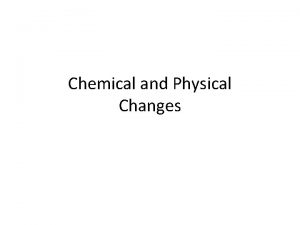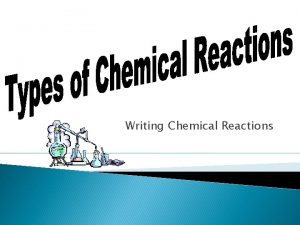Chemical Reactions Review Chemical Reactions Process that changes













- Slides: 13

Chemical Reactions Review • Chemical Reactions: – Process that changes one set of chemicals into another – Bonds are broken and reforming – Reactant(s) Product(s) – Energy is released or gained – Require activation energy

Chemical Reactions Review • Activation Energy: the minimum energy required to start a chemical reaction. • http: //www. youtube. com/watch? v=Vb. Ia. K 6 PLr. RM • Energy Diagram: Reaction occurs @ peak Reactants: Products:

Energy in Reactions Endothermic Reaction Exothermic Reaction

Catalysts • Substance that speeds up a chemical reaction by lowering energy barriers. • Biological Catalysts are called: ENZYMES

Enzymes • Are catalysts. • They speed up one type of chemical reactions that take place in cells. –They are substrate specific

Enzymes are Proteins • Review: – Elements: C, H, O, N – Monomer: Amino Acids – Polymer: Protein or Polypeptide • Proteins have 4 levels of organization

Four levels of organization Primary Structure: order of the amino acids in the protein chain Secondary Structure: the protein chain twisted or folded Tertiary Structure: the chain folded Quaternary Structure: clustering of multiple protein chains into the final three dimensional

Enzymes are Specific • Enzymes catalyze only one chemical reaction • Enzymes are commonly named by adding a suffix "-ase" to the root name of the substrate molecule it acts on or job it does. • What are the following enzymes acting upon? – Lipase – Lactase – Sucrase – RNAase

Enzyme-substrate Complex: Induced Fit Active Site

Coenzymes and Cofactors

Ideal Working Conditions • Enzymes have an optimal temperature and p. H range. • What temperature do enzymes work best in humans?

Enzyme Inhibitors • Inhibitors are molecules that prevent enzymes from working in their normal fashion • There are two types: – Nonspecific: Denatures enzymes • • Temperature p. H Alcohol Heavy Metals – Specific: Blocks or alters active sites. • Competitive • Noncompetitive

Competitive v. Noncompetitive
 Chemical reactions section 1 chemical changes
Chemical reactions section 1 chemical changes Chemical reactions section 2 classifying chemical reactions
Chemical reactions section 2 classifying chemical reactions Section 2 classifying chemical reactions
Section 2 classifying chemical reactions Chemical change example
Chemical change example Types of reactions
Types of reactions Chapter 8 review describing chemical reactions
Chapter 8 review describing chemical reactions Chapter 8 review chemical equations and reactions
Chapter 8 review chemical equations and reactions Chapter 18 chemical reactions balancing chemical equations
Chapter 18 chemical reactions balancing chemical equations Phân độ lown
Phân độ lown Block xoang nhĩ ecg
Block xoang nhĩ ecg Thơ thất ngôn tứ tuyệt đường luật
Thơ thất ngôn tứ tuyệt đường luật Thơ thất ngôn tứ tuyệt đường luật
Thơ thất ngôn tứ tuyệt đường luật Chiến lược kinh doanh quốc tế của walmart
Chiến lược kinh doanh quốc tế của walmart Tìm vết của mặt phẳng
Tìm vết của mặt phẳng

























